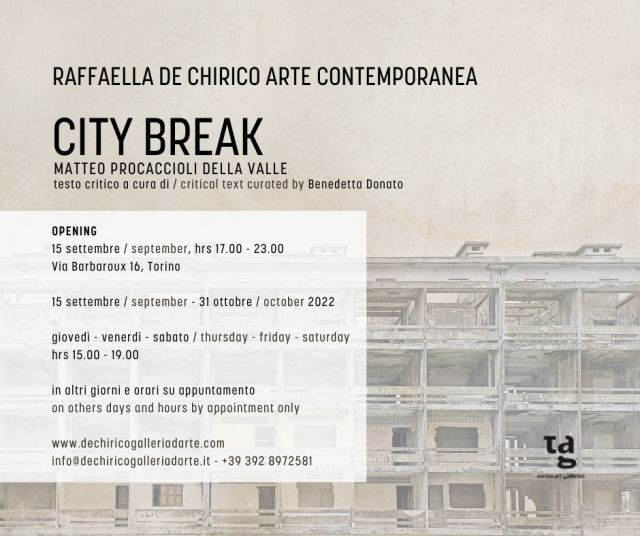Matteo Procaccioli Della Valle | CITY BREAK
From 15/09/2022 To 06/11/2022

"Knowing a city means above all knowing it through representation; devoting yourself to a city in artistic terms means accepting the representations of it that have been made; exploiting them perhaps to extract a pinch (the last?) of the original meaning.».
Lewis Baltz, The city and its double, Texts, 2013
The predominant sense of the journey through the research into the urban dimension by Matteo Procaccioli Della Valle is that of glimpsing as yet unknown meanings.
Conceiving of new scenarios signifies turning one’s gaze towards reality, through multiple levels of reality, shifting from existing buildings and architecture so as to propose something new. The revised perspective becomes perceptible in the final representation, thanks to a marked capacity for abstraction. This last presupposes a certain degree of reciprocity: it has to be as much the attitude of the author as that of the spectator. In other words, both experience a sense of disorientation and at the same time familiarity with respect to the visions presented here on the theme of the great cities.
The reflection lingers not on the object at the centre of the works, but goes beyond and embraces considerations regarding architecture, sociology, culture and what pertains to the identity of the places.
Here the confine between representation and abstraction becomes ever less clear and one manages to discern a broader discourse and even to catch sight of – together with the tangible and adroitly emphasized elements – all those meanings and symbols contained in these photographs.
The artist observes the urban structure from various points of view: in Microcities he soars over the city with daring shots from above, on the one hand reprising the identikit image of New York as designed by Le Corbusier and on the other recording a defragmented template of the city; in Structures he intercepts veins and graphic lines of constructions that appear to be enveloped in an evanescent, suspended and timeless space; in Urban Hives, he poses a question about architectural density that, on a second level of reading, suggests a homologated humanity dominated by the very constructions in which it lives. In this visual excursus, Procaccioli Della Valle seems to use photography as an open language to reawaken that absent human dimension and invite it to take another more sensitive look at places; to take up a front row seat before a mirror that finally succeeds in reflecting the reality of sites, the full, almost asphyxiating spaces and the voids in which the echo of a distant nature is increasingly loud.
The natural element is dissolved – intrinsically distant in these photos - – and the contemplation of the urban landscape becomes the observation of an abyss. With respect to the city or the megalopolis dimension, there is an identical sense of alienation, deriving from what Zygmunt Bauman defines as “ambivalent experience”: the city attracts and repels at the same time. Hence the abyss can become an interior and necessary space allowing us to re-establish a relational equilibrium between individuals, between the built and the natural landscapes, between urban and human density.
What emerges is a vitality of thought that aligns with the multiple ways of looking at the world and the ways it can be reported, finding correspondence not only in the exercise of composition, but in all the expressive modes and possibilities explored by Procaccioli Della Valle.
From the spectacle of the large format works, to the intimacy of the individual Polaroids, which exalt a detail and restore vigour to portions of reality... Almost as though they were cues for reflection on the inscrutable, on the most relevant form to restore to contemporaneity.
Rather than being a means of collecting immediately readable souvenirs of reality, the use of the instant film becomes an instrument and an incentive for reinterpreting it, an opening through which to receive its changes, its imperfections, at the very moment in which they appear, to interpret and manipulate them in a wholly new way.
The chromatic acrobatics are in fact eliminated, permitting the appearance of monolithic details with unusual features that, at certain moment, recall theatrical sets, such is the artist’s meticulous and vigorous intervention.
The final result is an upheaval of the meaning of the image, which may exaggerate the real or create space for it, to exalt a part of it, in an uninterrupted vitality of feeling, which translated into the act of seeing and observing portions of reality, inanimate and artificial but teeming with existence.
It is not in fact the state of things that moves and interests the artist’s thinking, but rather the regenerating energy which they conceal, that exists between idea, subject and gaze.
The confine between what appears as it is and the desire for distortion into how it should or could be, becomes tension relating to the unpredictability of life, searching for a possible meaning of liberty, harmony and equilibrium.
In other words, having gone beyond the confine, we are faced with the clear and original imagery of liveable potential.



